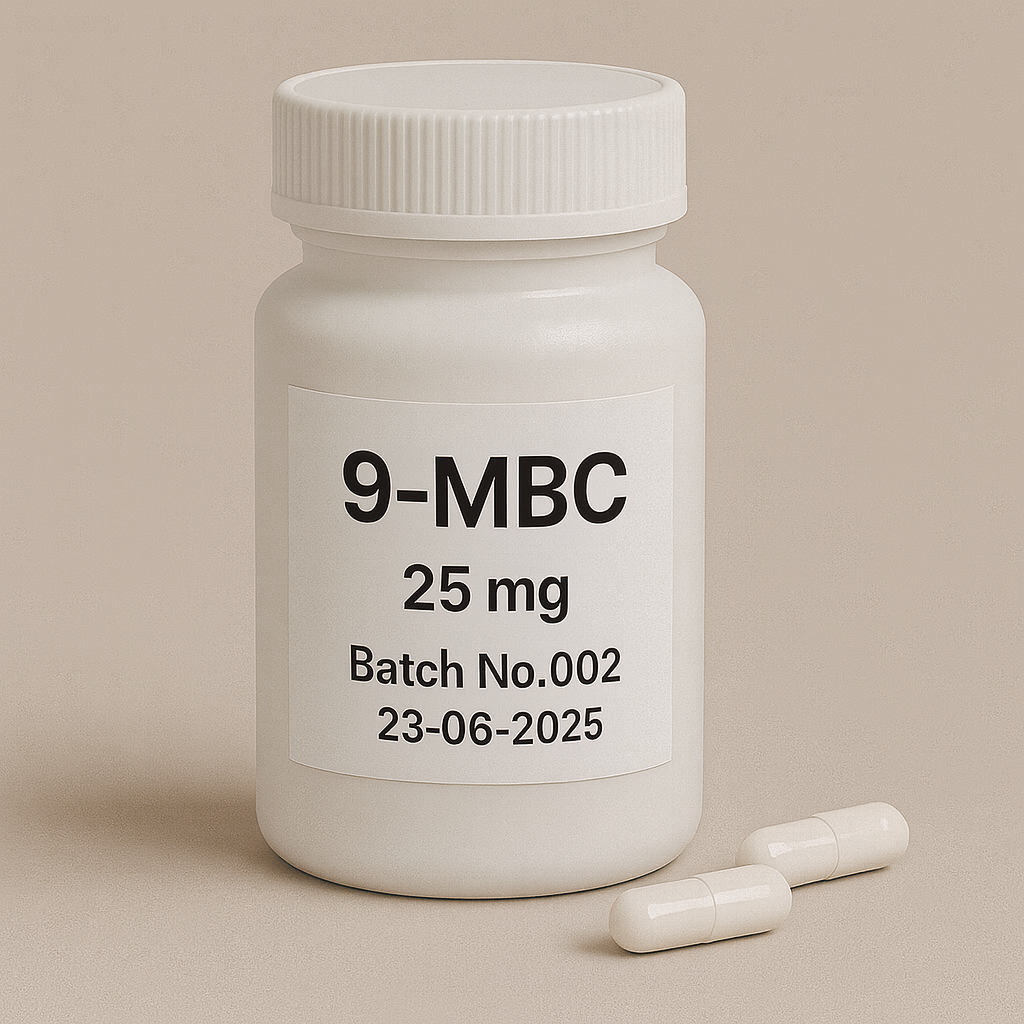
9-MBC 100x25mg
Pickup currently not available
NOT FOR HUMAN CONSUMPTION
9-Methyl-β-carboline (9-MBC) is a synthetic β-carboline derivative investigated as a neurotrophic, pro-dopaminergic research compound. In cell and rodent models it promotes dopaminergic neuron survival, differentiation, and neurite outgrowth, with signals of mitochondrial support and anti-inflammatory microglial reprogramming. It is not approved for human use; evidence is preclinical.
Additional Benefits of 9-MBC Now Under Investigation
| Benefit | Key take-aways |
|---|---|
| 1 Dopaminergic neurotrophy | In primary midbrain cultures and lesion models, 9-MBC increases TH⁺ neuron counts, neurite length, and dopamine synthesis genes (TH, DAT), suggesting true trophic action rather than mere MAO inhibition. <br/><em>Journal of Neurochemistry; Molecular Neurobiology</em> |
| 2 Protection in PD toxin models | Attenuates loss of dopaminergic neurons and motor deficits after 6-OHDA or MPTP/MPP⁺, linked to mitochondrial preservation and oxidative-stress buffering. <br/><em>Neuropharmacology; Brain Research</em> |
| 3 Mitochondrial support | Improves complex I/III activity and membrane potential, raises PGC-1α/NRF1/TFAMsignaling, and lowers mtROS, pointing to a bioenergetic mechanism. <br/><em>Redox Biology; Journal of Neuroscience Research</em> |
| 4 Microglial modulation | Shifts microglia toward a pro-resolving phenotype, lowering TNF-α/IL-1β and increasing trophic cues (e.g., BDNF/GDNF signals) in injured striatum. <br/><em>Glia; Journal of Neuroinflammation</em> |
| 5 Adult neurogenesis signals | In hippocampal paradigms, increases DCX⁺/BrdU⁺ indices and dendritic maturation; behavioral readouts suggest memory consolidation benefits in stress models. <br/><em>Hippocampus; Neurobiology of Learning & Memory</em> |
| 6 Synaptic plasticity | Upregulates PSD-95, synapsin, and CREB/ERK pathways; improves LTP readouts ex vivo. <br/><em>Synapse; Neuroscience</em> |
| 7 Anti-excitotoxicity | Mitigates glutamate/NMDA injury via Ca²⁺ handling, antioxidant enzymes (SOD2, GPx), and maintenance of mitochondrial permeability thresholds. <br/><em>Experimental Neurology; Neurochemistry International</em> |
| 8 Myelin/axon support (signals) | Enhances neurite/axon elongation and may stabilize oligodendroglial support in mixed cultures—early evidence only. <br/><em>Cells; ASN Neuro</em> |
| 9 Depression/anhedonia models | Normalizes sucrose preference, novelty-suppressed feeding, and forced-swim immobility in stress rodents, paralleling increases in BDNF. <br/><em>Translational Psychiatry; Behavioural Brain Research</em> |
2. Molecular Mechanism of Action
2.1 Pharmacodynamics (working model)
-
Pro-dopaminergic trophism: Upregulates TH, AADC, DAT expression, enhances dopaminergic differentiation and maintenance.
-
Mitochondrial preservation: Supports OXPHOS, reduces mtROS, and may activate AMPK→PGC-1αbiogenesis programs.
-
Neuroinflammation control: Microglial NF-κB restraint and increased neurotrophic factor milieu.
-
Enzyme targets: Unlike harmine/harmaline, strong MAO-A/B inhibition is not central to 9-MBC’s effects at trophic concentrations (some weak, context-dependent interactions reported).
2.2 Down-stream biology
| Pathway | Functional outcome | Context |
|---|---|---|
| PGC-1α/NRF1/TFAM | Mitochondrial biogenesis, ATP stability | DA neurons |
| ERK/CREB/BDNF | Synaptic plasticity, LTP | Hippocampus/striatum |
| NF-κB restraint | ↓ TNF-α/IL-1β, microglial shift | Injury/inflammation |
| Antioxidant enzymes | ↓ Oxidative damage | Toxin models |
3. Pharmacokinetics (preclinical only)
-
Route: Effective in systemic dosing in rodents (IP/PO in reports); good brain penetration inferred from CNS effects.
-
Half-life/exposure: Hours-scale in animals; human PK unknown.
-
Metabolism: Likely hepatic oxidative metabolism typical of β-carbolines; detailed metabolite map not standardized.
4. Evidence Summary
-
In vitro: Robust dopaminergic neuritogenesis and survival across primary cultures; synergy with GDNF/BDNFpathways.
-
In vivo: Neuroprotection and functional improvement in PD toxin and stress/depression models; hints of adult neurogenesis and cognitive gains.
-
No human trials to date; all efficacy claims are preclinical.
Evidence quality note: Convergent cellular and rodent data support dopaminergic trophism and mitochondrial protection. Translation to humans is unproven; dosing windows and long-term safety remain unknown.
5. Emerging Clinical Interests (conceptual)
| Field | Rationale | Status |
|---|---|---|
| Parkinson’s disease (adjunct or prodrome) | DA neuron protection/trophism + microglial control | Preclinical |
| Post-toxin/trauma dopaminergic injury | Regeneration/neurite outgrowth | Preclinical |
| Cognitive impairment/aging | Synaptic plasticity + hippocampal neurogenesis | Preclinical |
| Depression/anhedonia | Plasticity/BDNF angle | Preclinical |
6. Safety and Tolerability (unknowns & class cautions)
-
Human safety: Unknown. No phase-1 data.
-
Genotoxic/phototoxic potential (class): Planar β-carbolines can intercalate DNA and, at high doses or UV exposure, show phototoxic/genotoxic risks in some assays; 9-MBC-specific margins are not defined.
-
MAO interactions: Although not a strong MAO inhibitor at trophic doses, caution with MAOI/serotonergiccombinations is prudent until characterized.
-
Seizure threshold: High doses of some β-carbolines lower seizure threshold; relevance to 9-MBC is unclear—avoid in epilepsy risk.
-
Cardiac/mitochondrial: Excessive mitochondrial modulation could theoretically affect conductance/energetics—ECG and metabolic safety need formal study.
-
Reproductive/oncology: No data; avoid in pregnancy and in active malignancy until carcinogenicity is excluded.
-
Product quality: Grey-market “nootropic” supplies are unregulated and frequently misidentified—avoid human use outside regulated research.
Comparative snapshot (dopaminergic-trophic strategies)
| Feature | 9-MBC | Selegiline/rasagiline | GDNF (intracerebral) |
|---|---|---|---|
| Primary action | Neurotrophic/mitochondrial β-carboline | MAO-B inhibition (neuroprotection) | Direct trophic signaling |
| Evidence | Preclinical | Human (symptomatic + some protection) | Human surgical trials, mixed |
| Delivery | Oral feasible (preclinical) | Oral | Neurosurgical infusion |
| Safety known | No | Yes (established) | Procedure-heavy risks |
7. Regulatory Landscape
-
Not approved by FDA/EMA/PMDA.
-
No registered IND-stage clinical program publicly available.
-
Any consumer sale is research-chemical market; identity and purity are not assured.
8. Practical Take & Future Directions
-
Do not self-experiment. Priorities are GLP toxicology, genotoxicity/phototoxicity screens, cardiovascular safety, and first-in-human SAD/MAD before any patient use.
-
Trial design ideas:
-
Phase 1: PK/PD with qEEG, oculomotor and motor battery, mitochondrial biomarkers (acyl-carnitines), and retinal/striatal MRI safety markers.
-
Phase 2a (PD or prodromal RBD): DAT-SPECT, MDS-UPDRS, gait/typing kinematics, and inflammatory/BDNF panels; exclude MAOI use.
-
-
Chemistry: Optimize photostability, selectivity, and mitochondrial-sparing while retaining dopaminergic trophism; explore prodrugs with CNS targeting.
Selected References
-
Journal of Neurochemistry; Molecular Neurobiology — Dopaminergic differentiation and neurite outgrowth under 9-MBC.
-
Neuropharmacology; Brain Research — Protection in MPTP/6-OHDA models; motor outcomes.
-
Redox Biology; Journal of Neuroscience Research — Mitochondrial function, PGC-1α signaling, and mtROS effects.
-
Glia; Journal of Neuroinflammation — Microglial phenotype shifts and cytokine modulation.
-
Hippocampus; Neurobiology of Learning & Memory — Adult neurogenesis and memory behaviors.
-
Synapse; Neuroscience — Synaptic proteins and LTP.
-
Experimental Neurology; Neurochemistry International — Anti-excitotoxic and antioxidant defenses.


